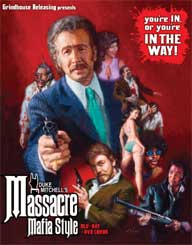 MASSACRE
MAFIA STYLE (1978) Blu-ray/DVD combo
MASSACRE
MAFIA STYLE (1978) Blu-ray/DVD comboDirector: Duke Mitchell
Grindhouse Releasing
 MASSACRE
MAFIA STYLE (1978) Blu-ray/DVD combo
MASSACRE
MAFIA STYLE (1978) Blu-ray/DVD comboDuke Mitchell's low-budget epic answer to THE GODFATHER finally hits Blu-ray courtesy of its champions Grindhouse Releasing.
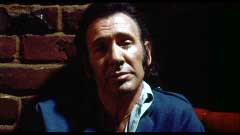
Having lived in exile with his father Don Miceli (Lorenzo Dodo) in Palermo, widower Mimi Miceli (Mitchell, PARADISE ALLEY) leaves behind his six-year-old son and heads to Los Angeles to conquer Hollywood. Discovering that the Sicilian mafia traditions are a thing of the past, and that the reach of Don Miceli's influence is only a matter of respect for who he had been, Mimi teams up with childhood friend Jolly Rizzo (Vic Caesar, ALICE GOODBODY) and abducts the Don's former lieutenant/now top man Chucky Tripoli (Louis Zito, SAVAGE STREETS) and holds him for ransom and send his severed finger as proof ("That's his finger, alright. I've seen it on him a million times!"). The local Dons are divided on how to respond, with fellow Sicilian Zantelli (Richard Scarso, SOLOMON KING) wants to pay up while Baccari (George "Buck" Flower, THE FOG) does not want to back down to intimidation. Cooler heads prevail and Tripoli is returned, only for Mimi and Jolly to crash his son's wedding announcing their intent to pursue the pimping and bookmaking concessions.
 Rubbing
out the competition, Mimi makes a name for himself among the Dons and snags
gal Liz (Cara Salerno, SPACE THING). Don Miceli seems not to have taken notice
of his son's achievements but objects to the Greek's (George Angelopoulos) dope
dealings and orders Tripoli rub him out. The Don is shocked when he learns that
Mimi and Jolly carried out the hit – as well as additional ones on the
Greek's partners – and sends his lieutenant Bones (Fred Otash, THE GREAT
SEX WAR) to literally slap some sense into his son to go straight. Respecting
his father's wishes, Mimi and Jolly get into porn filmmaking but come to realize
the only way to turn a profit is to do themselves, including getting the girls.
When top pimp Super Spook (Jim Williams, COCKFIGHTER) refuses to work with them,
they take him out and start a new war with the Dons that will become an all-out
mafia massacre.
Rubbing
out the competition, Mimi makes a name for himself among the Dons and snags
gal Liz (Cara Salerno, SPACE THING). Don Miceli seems not to have taken notice
of his son's achievements but objects to the Greek's (George Angelopoulos) dope
dealings and orders Tripoli rub him out. The Don is shocked when he learns that
Mimi and Jolly carried out the hit – as well as additional ones on the
Greek's partners – and sends his lieutenant Bones (Fred Otash, THE GREAT
SEX WAR) to literally slap some sense into his son to go straight. Respecting
his father's wishes, Mimi and Jolly get into porn filmmaking but come to realize
the only way to turn a profit is to do themselves, including getting the girls.
When top pimp Super Spook (Jim Williams, COCKFIGHTER) refuses to work with them,
they take him out and start a new war with the Dons that will become an all-out
mafia massacre.

Born Dominic Miceli, Duke Mitchell's primary passion was signing with only a few forays into acting like BELA LUGOSI MEETS A BROOKLYN GORILLA in which he and the irritating Sammy Petrillo were manufactured into a sub-Martin and Lewis-like singing duo and the singing voice of Fred Flintstone in a special episode. He spent much of the 1950s and 1960s performing live from Palm Springs to Vegas before trying out Hollywood and buying a piece of the lounge Ciro's. In the 1970s, he would sell off his interest to fund his own movie. Drawing from his own Italian heritage, Mitchell mafia picture uses Italian and Sicilian traditions as more than just window dressing and attempts to match THE GODFATHER's baptism montage with the crucifixion of one of Mimi's enemies on Easter Sunday. In the fashion of a low budget filmmaker thinking he might only get one chance to express himself, the eighty-three minute film attempts to encompass an epic story spanning roughly fifteen years. Mitchell does not romanticize the mafia – even giving a climactic monologue about how there is no room for men like Mimi's father in the new world where politicians and presidents have their own mafias, and THE GODFATHER movie is just a caricature – and his "like father, like son" ending veers from optimistic to cynical in a darker fashion than the Puzo novel and Coppola film. The structure is choppy with a decade passing between scenes with mention of Mimi's son now in private school in Milan and then a couple more years as Mimi and Jolly move on to porn. A lot of it seems quick 'n dirty and on-the-fly but a look at the shooting script (included in the DVD-ROM extras) shows that the finished film is mostly as Mitchell intended and not pieced together from what could be achieved on-schedule. Mitchell also scores the film with a mix of gleeful songs to accompany the violence (one bit seems less evocative of Dick Smith's work on the Coppola film than of the excesses of the Italian crime and gangster films). The end result may not be a cinematic masterpiece, but it certainly is Duke Mitchell's masterpiece. His follow-up GONE WITH THE POPE was shot but remained unfinished until a few years ago when Grindhouse's Bob Murawski completed the editing, and it remains to be seen how it compares.
 Released
originally as LIKE FATHER, LIKE SON (the title on the end credits of this release)
in New York by Mitchell himself, the film first received wider release through
Matt Cimber's Moonstone Entertainment as MASSACRE MAFIA STYLE (with another
reissue by Larry Joachim who also distributed CANNIBAL HOLOCAUST and a handful
of Sonny Chiba movies), the film made its VHS bow as THE EXECUTIONER from Video
Gems where it caught the attention of Grindhouse's Sage Stallone who restored
it in 2006. Finally available on digital media, Grindhouse's MPEG-4 AVC 1.85:1
widescreen transfer looks as spectacular as the original rushed cinematography
(cinematographer Ken Gibb would become a regular for Bob Chinn in the eighties)
allows with detailed close-ups and bold colors, with only a handful of out of
focus night exteriors and interiors looking poorer. Audio options include DTS-HD
Master Audio 1.0 and Dolby Digital 2.0 mono tracks (only selectable from your
remote) that highlight the music score, songs, and gunplay.
Released
originally as LIKE FATHER, LIKE SON (the title on the end credits of this release)
in New York by Mitchell himself, the film first received wider release through
Matt Cimber's Moonstone Entertainment as MASSACRE MAFIA STYLE (with another
reissue by Larry Joachim who also distributed CANNIBAL HOLOCAUST and a handful
of Sonny Chiba movies), the film made its VHS bow as THE EXECUTIONER from Video
Gems where it caught the attention of Grindhouse's Sage Stallone who restored
it in 2006. Finally available on digital media, Grindhouse's MPEG-4 AVC 1.85:1
widescreen transfer looks as spectacular as the original rushed cinematography
(cinematographer Ken Gibb would become a regular for Bob Chinn in the eighties)
allows with detailed close-ups and bold colors, with only a handful of out of
focus night exteriors and interiors looking poorer. Audio options include DTS-HD
Master Audio 1.0 and Dolby Digital 2.0 mono tracks (only selectable from your
remote) that highlight the music score, songs, and gunplay.
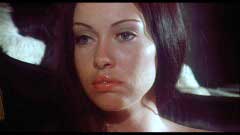
The principal extra is the "Like Father, Like Son" featurette (43:33) which includes interviews with Mitchell's son Jeffrey – a musician in his own right – as well as friends George Jacobs and Frankie Ray. None of them worked on the film – Jeffrey was in England working on his own music career with Suzi Quatro – but it provides a dimensional picture of an entertainer who took no bullshit and more than likely severely limited his career opportunities for that very reason. Stories about Mitchell's friendships with Henry Fonda, Jerry Lewis, Shecky Greene, and Sammy Davis Jr. (who shot Mitchell with a gun full of blanks), and Frank Sinatra (as well as Mitchell's own run-ins with Mia Farrow) flow freely as Jeffrey recalls singing with his father as a kid and splitting with him over rock 'n roll (particularly the younger Mitchell's idolization of Jimi Hendrix), but he can appreciate MASSACRE MAFIA STYLE now because he recognizes some of his father's humor in the work. He also recalls his father's hatred of agent Maurice Duke who forced the Mitchell/Petrillo pairing (he alleges his father actually did to the agent what Mimi and Jolly do to Jewish Don Lowenstein [Ron Chazin] to scare him). Mitchell and Jacobs are of the opinion that the film would have been less racial with its many black victims and liberal use of the "N" word had Jacobs played Jolly as originally intended.
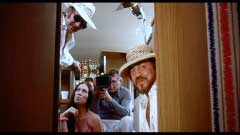 Matt
Cimber (THE WITCH WHO CAME FROM THE SEA) and Jim Lobianco – Mitchell's
friend and GONE WITH THE POPE co-star – also appear in an interview (10:10)
in which Cimber recalls how "overwhelmed" Mitchell was by THE GODFATHER.
Cimber first saw the film in pieces since it was being shot around the availability
of Mitchell's friends and resources and went on the recommendation of his company's
head of distribution. He and Lobianco discuss the film's dark humor and other
ways it differed from the Coppola film, and Cimber also vaguely recalls how
the film performed in theaters (Cimber also appears in two additional Easter
Eggs in snippets of the interview discussing somewhat tangential topics). The
Duke Mitchell home movies (52:01) were shown in the background during Mitchell's
stage shows, and each of them is scored with one of Mitchell's performances
– including two versions of "Pagan Love Song" (one a duet with
his son Jeffrey) and a live recording from 1960 – to give an idea of the
effect.
Matt
Cimber (THE WITCH WHO CAME FROM THE SEA) and Jim Lobianco – Mitchell's
friend and GONE WITH THE POPE co-star – also appear in an interview (10:10)
in which Cimber recalls how "overwhelmed" Mitchell was by THE GODFATHER.
Cimber first saw the film in pieces since it was being shot around the availability
of Mitchell's friends and resources and went on the recommendation of his company's
head of distribution. He and Lobianco discuss the film's dark humor and other
ways it differed from the Coppola film, and Cimber also vaguely recalls how
the film performed in theaters (Cimber also appears in two additional Easter
Eggs in snippets of the interview discussing somewhat tangential topics). The
Duke Mitchell home movies (52:01) were shown in the background during Mitchell's
stage shows, and each of them is scored with one of Mitchell's performances
– including two versions of "Pagan Love Song" (one a duet with
his son Jeffrey) and a live recording from 1960 – to give an idea of the
effect.
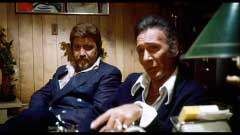
Besides the extras, the Blu-ray side of the package also includes to bonus features. BELA LUGOSI MEETS A BROOKLYN GORILLA (1952; 74:19) finds a young Mitchell and Petrillo at the mercy of a mad doctor (Lugosi) who wants to literally make a monkey out of Mitchell over a native girl (Charlita, GREEN FIRE). Directed by the prolific William "One Shot" Beaudine, who directed almost two hundred features between the 1920s and 1960s (with at least seventy-five alone in the 1940s), the film is remembered mainly as one of Lugosi's last roles (apart from THE BLACK SLEEP and his Ed Wood special appearances). The standard definition, fullscreen presentation looks quite good upscaled to HD, and is probably your best bet for this PD eyesore. Also included are the film's theatrical trailer (2:10) – the trailer is also available on the Duke Mitchell filmography page – and a still gallery. The other feature is the unaired television special AN IMPRESSIONISTIC TRIBUTE TO JIMMY DURANTE (37:05) in which Mitchell sports a prosthetic nose and sings a number of hits by the performer. The special was shot in 16mm but only exists in complete form as a video master with occasional damage, although a handful of dailies still exist in 16mm (6:32).
 The
remaining extras consist of the film's theatrical trailer (2:18) as well as
two radio spots for the MASSACRE MAFIA STYLE version and two for the LIKE FATHER,
LIKE SON release (as well as a spot featuring testimonials of viewers produced
for Mitchell's New York release), five extensive still galleries, filmographies
for Mitchell and Salerno (with a trailer for Byron Mabe's SPACE THING among
the credits), as well as trailers for the current and upcoming Grindhouse releases
CANNIBAL FEROX, CANNIBAL HOLOCAUST, THE BEYOND, PIECES, AN AMERICAN HIPPIE IN
ISRAEL, Mitchell's GONE WITH THE POPE (also available from Mitchell's filmography
page), THE TOUGH ONES, POOR WHITE TRASH 2, CAT IN THE BRAIN, I DRINK YOUR BLOOD,
CORRUPTION, THE BIG GUNDOWN, THE SWIMMER, and ICE HOUSE. The DVD reproduces
much of the Blu-ray content – including Easter Eggs – except for
BELA LUGOSI MEETS THE BROOKLYN GORILLA, the Durante special, and their associated
extras. DVD-ROM extras include the film's shooting script (83 pages) as well
as an earlier 120-page version with a different opening, a seven page treatment
as well as a twenty-three page version atypically told in first person, as well
as a typed opening narration and a few pages of handwritten notes (including
a glossary of Italian expletives). David Szulkin contributes brief but extremely
informative liner notes which are found in the ten-page booklet.
(Eric
Cotenas)
The
remaining extras consist of the film's theatrical trailer (2:18) as well as
two radio spots for the MASSACRE MAFIA STYLE version and two for the LIKE FATHER,
LIKE SON release (as well as a spot featuring testimonials of viewers produced
for Mitchell's New York release), five extensive still galleries, filmographies
for Mitchell and Salerno (with a trailer for Byron Mabe's SPACE THING among
the credits), as well as trailers for the current and upcoming Grindhouse releases
CANNIBAL FEROX, CANNIBAL HOLOCAUST, THE BEYOND, PIECES, AN AMERICAN HIPPIE IN
ISRAEL, Mitchell's GONE WITH THE POPE (also available from Mitchell's filmography
page), THE TOUGH ONES, POOR WHITE TRASH 2, CAT IN THE BRAIN, I DRINK YOUR BLOOD,
CORRUPTION, THE BIG GUNDOWN, THE SWIMMER, and ICE HOUSE. The DVD reproduces
much of the Blu-ray content – including Easter Eggs – except for
BELA LUGOSI MEETS THE BROOKLYN GORILLA, the Durante special, and their associated
extras. DVD-ROM extras include the film's shooting script (83 pages) as well
as an earlier 120-page version with a different opening, a seven page treatment
as well as a twenty-three page version atypically told in first person, as well
as a typed opening narration and a few pages of handwritten notes (including
a glossary of Italian expletives). David Szulkin contributes brief but extremely
informative liner notes which are found in the ten-page booklet.
(Eric
Cotenas)